#Coenobita clypeatus
Explore tagged Tumblr posts
Text
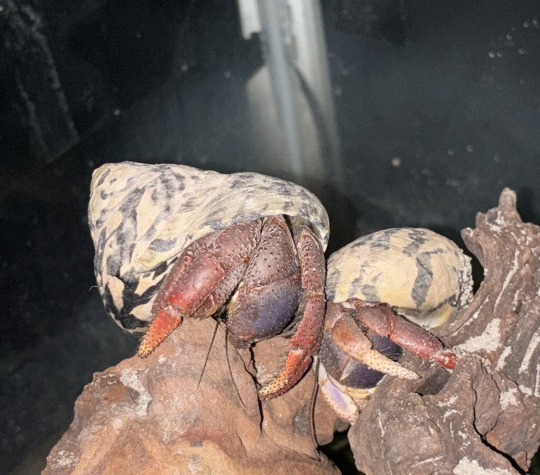
a personal shot of two members of my colony
4 notes
·
View notes
Text


Caribbean hermit crabs (Coenobita clypeatus) By: Fredric L. Frye From: Captive Invertebrates 1992
#hermit crab#crustacean#arthropod#invertebrate#1992#1990s#Fredric L. Frye#Captive Invertebrates (1992)
141 notes
·
View notes
Text
Since my zoology posts have recently been gaining traction on my account, I'd like to take a leap and publish an old video that I believe supports my hypothesis that arthropods (and potentially all invertebrates) are capable of entering states of REM sleep, and therefore have the capability to dream. I've had this hypothesis since I've recorded this footage of my old centipede, Tambora Naga (Scolopendra subsinepes) in June of 2023, but was met with skepticism and doubt... until this study was recently popularized by TikTok and Instagram users who are fascinated with jumping spiders.
In this footage, Tambora can be seen asleep twitching and moving several of her appendages: her forcipules (often called the 'jaws'), the tip of her antennae, and even a fierce kick from one of her back legs. This can be compared to behaviors in terrestrial vertebrates - organisms that are capable of REM sleep (and dreaming) - where limbs may move and/or curl.
Now almost two years after this footage was taken, I've finally successfully transferred to a 4-year university where I am completing my bachelors of the sciences and potential masters in environmental biology to study the intelligence and psychology of arthropods and invertebrates. I hope that continued research of my own and others can help prove the theory that these animals have much more going on behind the scenes.
I am also working to study venomous invertebrates and the medical potential of animals such as centipedes and scorpions, but that is besides the point.
Tambora unfortunately passed away of a presumed age-related death, and since then, I have owned a handful of centipedes but have failed to document this exact behavior. I'm currently trying to replicate this behavior in Madagascar hissing roaches (Gromphadorhina portentosa) and Purple pincher hermit crabs (Coenobita clypeatus).
#oc#entomology#zoology#insects#pets#arachnids#arthropods#myriapods#centipede#science#biology#invertebrate#bugblr#insect#bug#arachnid
57 notes
·
View notes
Text
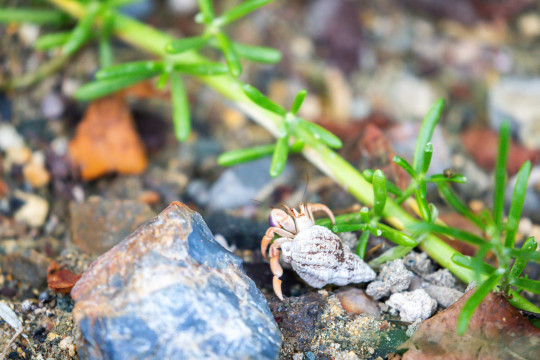
Caribbean land hermit crab (Coenobita clypeatus) on Cabo Rojo, Puerto Rico
17 notes
·
View notes
Text
Although land crabs regularly appear in the exotic pet trade, there is not much care information around for these species, excepting the most widely traded of the land hermit crabs, Coenobita clypeatus. For a while much confusion surrounded the rainbow crab of West Africa, Cardisoma armatum, and the moon crabs of the grnus Gecarcinus, which are imported from the opposite side of the Atlantic. I had myself thought the moon crabs, traded at a smaller size than the rainbow crabs, were a growth stage of that species. The similarities were not merely superficial, because both genera are members of Gecarcinidae, a major clade of land dwelling crabs. At least two species of Gecarcinus were turning up, these being G. lateralis and G. quadratus.
A well studied species, G. lateralis might be thought of as the ordinary moon crab, and most of my scientific information pertains from descriptions of this species, which is also called the Bermuda land crab and the black-back land crab, as well as some other names. Whatever it is being called, G. lateralis is present in coastal environments, where it lives above the tide mark, including where there is no standing water. Reportedly G. lateralis can grow to attain a carapace as long as 10 to even 12 centimeters, or 4 to almost 5 inches, and a legspan that is 15 centimeters or 6 inches. If such specimens exist then they are rare. A study of the burrowing behavior of this species in forest habitat, did not indicate any of such large crabs, their carapaces measuring closer to 5 centimeters or 2 inches when mature. However in a related species, G. ruricola, large males and slightly smaller females are demonstrated to possess carapaces about 9 centimeters wide, whilst 5 or 6 centimeters would be a more common carapace width.
The related species G. quadratus also has many names, but the Halloween (moon or land) crab is by far the most widely encountered, at least in the exotic pet trade. It may also be encountered with the labelling of harlequin land crab, among others. These two names do not seem to be in use when referring to any other Gecarcinus species, all of which may for example be referred to as red land crabs or moon crabs - labels shared with land crabs from other gecarcinid genera. G. quadratus is a native of the coastal rainforests of Mexico and the Panamanian land bridge, that attaches North to South America. This species has a carapace length of about 5 centimeters or 2 inches. I do not have a clue as to how variable in size this species of Gecarcinus is. Although it is clear that mature members of species in Gecarcinus, may show size variation.
Although Gecarcinus sp. larvae are dependent upon saltwater for their survival, the adult crabs have no such requirement. Although they might be found on beaches and in estuarine environments, adult G. lateralis died at salinities of 30 and 35 ppt, whereas they flourished in freshwater, and at lower salinities of 15 and 20 ppt. I do not have information about the salinity tolerance of G. quadratus, but adults belonging to both species do perfectly fine with access only to fresh water. These crabs are obligate air breathers and no not, in fact, require an aquaterrarium, provided their substrate is damp, or they have access to shallow water in a bowl or dish. This is because these crabs take up water using their abdomens. G. lateralis is also known to ingest damp sand for its moisture content.
Both G. lateralis and G. quadratus are present in environments where the substrate allows for burrowing behavior, and there is plenty leaf litter. Conspecific crabs are present in vast numbers, might share an environment, and this might be thought apt for these species the aquaterrarium, considering their herding habits in the wild. Nonetheless, each of these crabs will need space to avoid the behavioral incidents arising from overstocking. Cohabiting crabs would also need a complex environment, which they can use to avoid confrontations among their kind when necessary, not least if they are molting, because the presence of conspecifics reduces the survival of molting crabs. These crabs molt inside their own burrows for protection during this vulnerable, temporary time. Although this genus has strong herbivorous leanings, the older crabs are known to kill their juvenile conspecifics for food, especially when they are under nutrient stress
Gecarcinus are classed among the herbivorous crabs, and they do possess the abilities to digest cellulose, and consume fibrous plant materials. However their herbivory is not total, and foods of animal origins are accepted. Their diets are 80% vegetarian whereas it is only 10% of arthropod origins, and they can consume both green and brown (dead) plant matter. Although they prefer to eat fresh plant material, the wild crabs might consume more leaf litter. G. lateralis is a significant consumer of seeds, fruits, and propagules, avoiding vegetable foods with strong alkaloid defences. There is reason to believe genus Gecarcinus consume a broader spectrum of foods in the dry season, including fruits and carrion. Cannibalism in these crabs increases when access to nitrogen is decreased.
Gecarcinus sp. are burrowing crabs, and they use their burrows to shelter in less hospitable seasons, plugging their burrow and storing leaves as their food supply, when the temperature drops and the air humidity decreases. This behavior assists them avoiding water loss in the dry season. For this reason the air temperatures in the vivarium housing Gecarcinus sp. should not drop as low as 15-18 degrees centigrade, unless one wishes to stimulate such behaviors, by simulating a Caribbean dry season. The crabs seem to use decreasing air temperature as their cue for this behavior, but are triggered to resume behavioral normalcy by increased rains and the return of higher air humidity.
These crabs in the vivarium require a dump substrate and a high air humidity of over 80%, based on the humidity inside crab burrows. The diurnal air temperature range, on a similar basis, should be closer to 28 degrees than to 20 degrees centigrade. People report success when keeping this species at 26 or 27 degrees by day. I have read that this temperature must not be allowed to fluctuate, but in the wild the air temperature in their habitats does drop a little by night, and Gecarcinus are night as well as day active foragers. If the environment makes them unhappy they will retreat into the microhabitats of their burrows. Although not necessary, these air breathing land crabs are easily accommodated in a paludarium, with a large land portion simulating a tropical forest floor.
The water portion of an aquaterrarium assists in maintaining a high air humidity, but these crabs do need to safely leave the water should they walk or fall in. For this reason any water area should be of a shallow depth, and the substrate ought to slope out of the water. As with all humid vivaria, it is also important that there is sufficient ventilation. Although the air should have a high moisture content, it does not follow that it be stagnant. I have not heard reports of Gecarcinus sp. being mixed with other species of land or water animals. However, gecarcinid crabs are strongly inclined to eat live plants, and destroy planted landscapes.
Gecarcinus are primarily feeders on edible fruits and vegetables, that will also accept proprietary defrosted and dry foods intended for aquarium fishes. Although they are predominantly vegetarians, Gecarcinus diets in the aquaterrarium should also include some animal proteins, to reflect their natural consumption of arthropod material, but they will also consume soybean based foods that offer a similar boost of nutrients. The opportunistic consumption of animal matter is a well known phenomenon in terrestrial crabs with herbivorous specializations.
#moon crabs#aquaterrarium pets#amphibious crabs#land crabs#genus gecarcinus#Gecarcinus lateralis#Gecarcinus quadratus#Bermuda land crab#red land crab#black-back land crab#halloween land crab#harlequin land crab#herbivorous crabs
3 notes
·
View notes
Text
Probably the first time Kilgarrah has let me get close enough for a good video :3
Because she’s so large I got some really good shots of her maxillipeds (her mouthparts)! You’ll notice she uses her small claw to bring food up and the maxillipeds reach down to grab it. It’s really interesting to see.
Wholesome music included~
#bugs#the crabitat#hermit crabs#Kilgarrah#Crustacea#Malacostraca#Decapoda#Coenobitidae#Coenobita#Coenobita clypeatus#man I wish I had maxillipeds
3 notes
·
View notes
Text
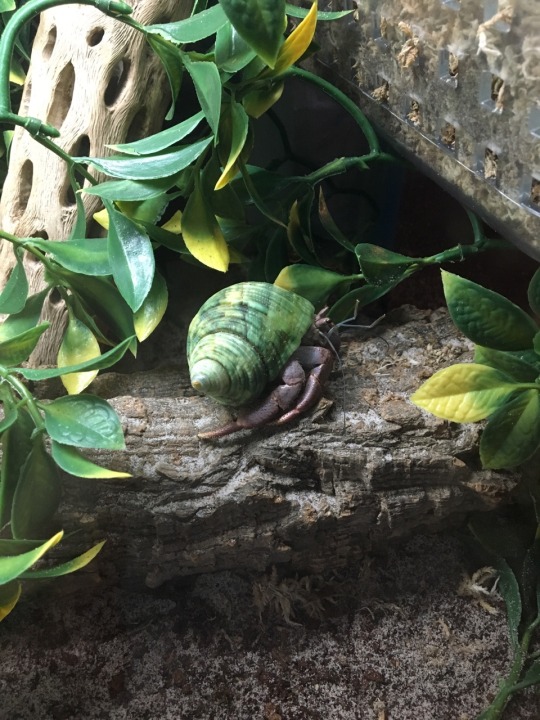
Merle has definitely been the most active as of recent!
#merle#hermit crab#hermit crabs#hermies#pet#pets#shell#shells#purple pincher#coenobita clypeatus#adorable#cute
17 notes
·
View notes
Photo
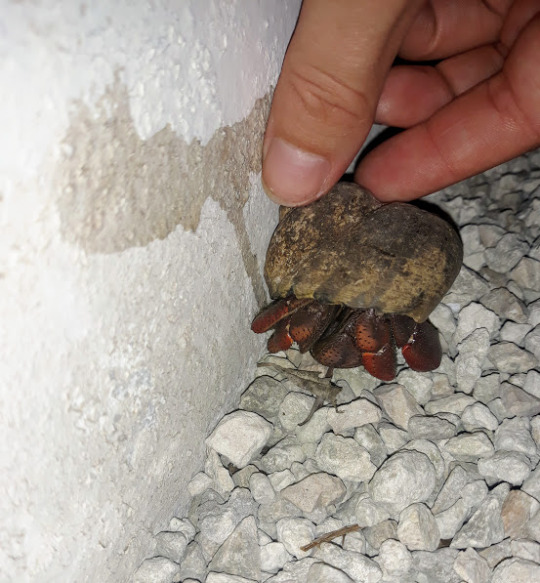
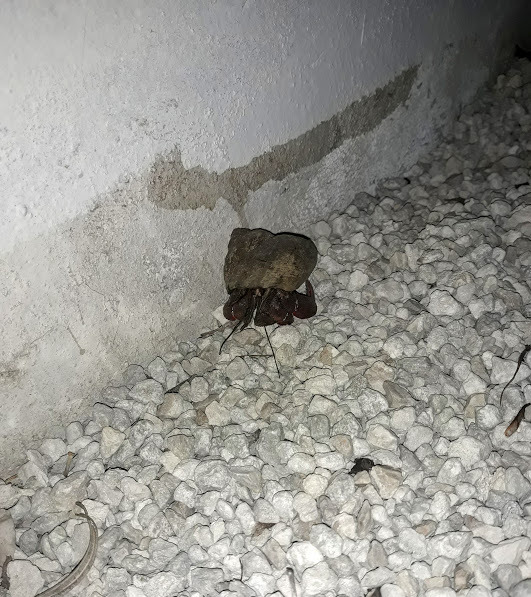
Please enjoy this adorable (and big!) Caribbean hermit crab, Coenobita clypeatus!
San Miguel de Cozumel, 2019
#Coenobita clypeatus#mexico#cozumel#san miguel#san miguel de cozumel#summer 2019#mexico trip#mine#hermit crab#crab#land hermit crab#caribbean hermit crab#caribbean#caribbean animals#travel
21 notes
·
View notes
Text
youtube
Shellby’s great. I still haven’t found him a tankmate, sadly. Soon I’ll get the crustaceans, mollusks, and fish for the new saltwater tank. So excited!!
#Crustacean#Crab#Hermit Crab#Hermit Crabs#Coenobita#Clypeatus#Coenobita clypeatus#Purple pincher hermit crab#Cute#Decapod#Mollusks#Fish#Saltwater#Saltwater tank#Tank
2 notes
·
View notes
Photo
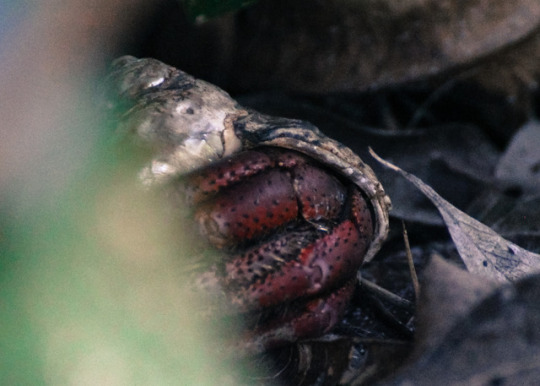

A very shy Caribbean Hermit Crab, Soldier Crab, West Atlantic Crab, Tree Crab, or Purple Pincher Coenobita clypeatus
Magens Bay, St. Thomas, United States, 2014 Magens Bay
#caribbean hermit crab#soldier crab#west atlantic crab#tree crab#purple pincher#coenobita clypeatus#coenobita#terrestrial hermit crab#coenobitidae#hermit crab#decapod#decapoda#malacostracan#malacostraca#arthropod#arthropoda#invertebrate#crustacean#crustacea#Magens Bay#St. Thomas#USVI#United States
13 notes
·
View notes
Text
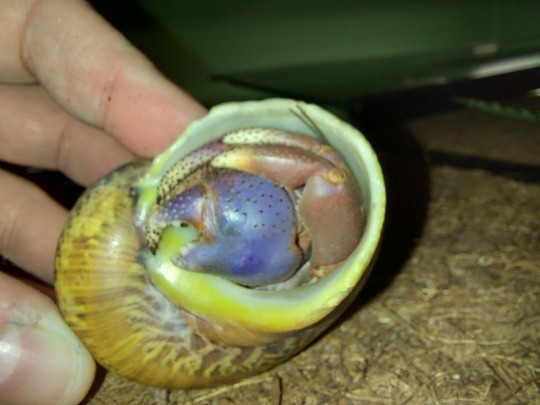
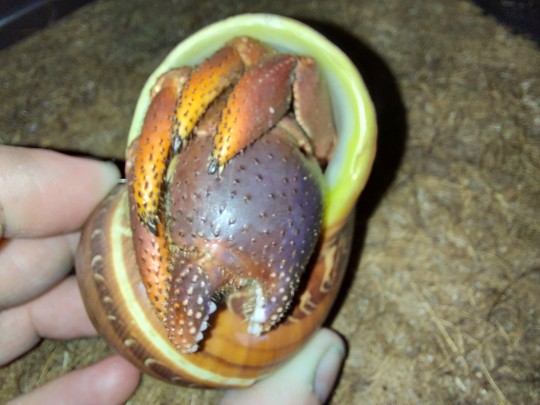

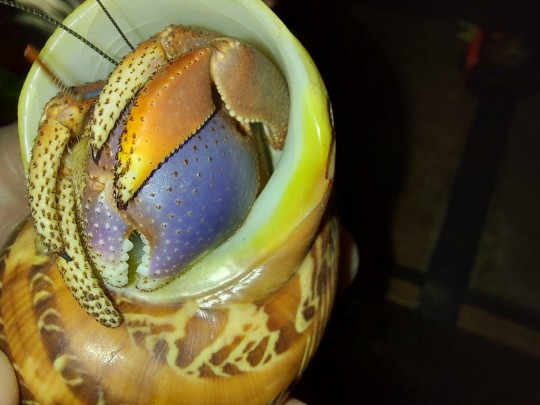
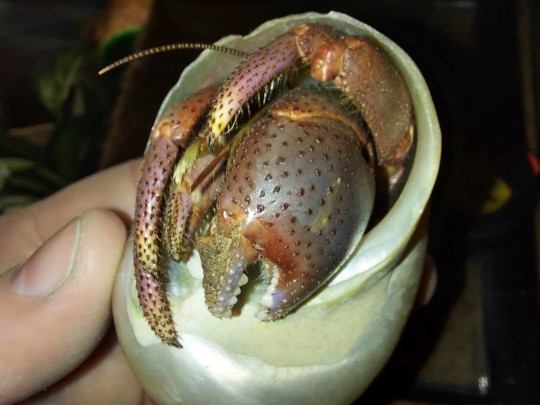
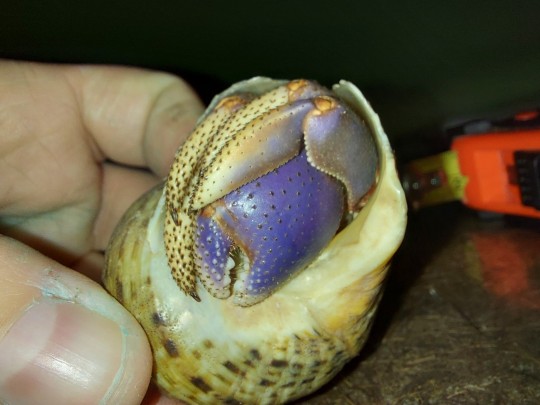



A look at the color variety of my crabs - these are all Coenobita Clypeatus, the purple pincher hermit crab. Pictures 7 & 8 are the same crab, the rest of the pics are all different ones.
Picture 6 is a very purple boy all over, with cream highlights. He's gorgeous! Picture 4 has a palm tree shell on and I like that her legs are sunset colored.
The last pic is Hagrid, who was brick red when I got him, but had turned very brown since - I wonder if he eats more tannins in my tank?
22 notes
·
View notes
Photo

#brosforlife View on Instagram
0 notes
Note
But wait. What about Don Thousand? He's a barian too. AND cleraly a predator.(Although, you could argue that's because he was originally an Astral being). But what about Fearsome Four? They have mouths too in their barian forms.(Although, Kaninja and Semimaru's mouths are that of the insects they are based on.) So not all barians are innocent. Only the Seven Emperors.
(you asked for this anon ~ love Dyzarc)
I apologize for not delving into Don Thousand in my previous analysis, but in my experience, I was strictly taught that my papers should get to the point with the arguments being clear and concise. This includes omitting irrelevant information that adds nothing to the thesis. Don Thousand is certainly an interesting case in the Barians (and I’ll gladly talk about him this time) but originally, he didn’t fit into the analysis. Every point I wanted to cover was better done using the Seven Emperors — the acid sea, the predator, carapaces, molting, ect — and throwing Don Thousand into the mix would have bloated up the analysis with redundant data. Furthermore, if I wanted to talk about Don Thousand, the analysis would end being twice as long. And I’m sure none of you want to read that.
However, anonwhoshouldrevealthemselfsowecanmeetbehindadarkallyway, I take the full blame of overlooking the Fearsome Foursome as you will take the full blame of allowing Dyzarc to do this. This particular group of feral Barians are a very unique case in Barian Biology since, well, look at these ugly fuckeroos
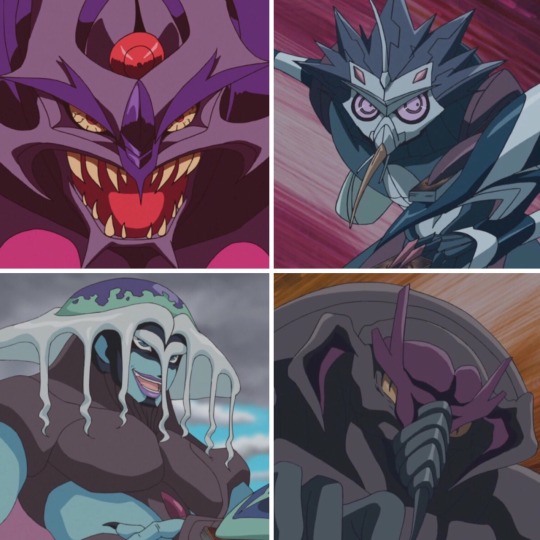
And since they differ from the Seven Emperors to a high degree, I will certainly go in-depth on these Barians.
DISCLAIMER: If you didn’t read the previous post, please feel free to do so. I’ll expand and refer to certain points in there, so you might be scared confused if you don’t. Also, I will not be primarily addressing their incapability or capability to vore. Everything I mentioned previously continues to hold true for the most part, and it can be applied to all five of the unaddressed Barians. However, there are some abnormalities present that I wish to discuss (Chironex and Mr. Heartland, for example). This post will mainly be explaining their anatomy and so-forth rather than focus on why they absolutely cannot vore. Furthermore, these Barians do function a tad bit differently than the other ones, and I’ll talk more about this later. There will be a section at the bottom that focuses on the vore issue since I KNOW that’s what you folks are here for, but other than a sprinkle of discussion (mostly in relationship to their predator) throughout the passage, it will be vore-free.
Forthemostpart so let us begin
Zarc N’ Pals Installment 1, Detour 1 GO!
So now that I am given the opportunity to talk about Don Thousand, I’ll fucking talk about Don Thousand. I have a lot to say about Donny, so if you only wanna see my discussion on the Fearsome Foursome, move your cursor to the scrollbar and pull down because you won’t see the end of this for miles.
Don Thousand is the Gustave of Barians. He is HUGE. An absolute unit. I’m not even joking.
These are some standard-sized Barians:
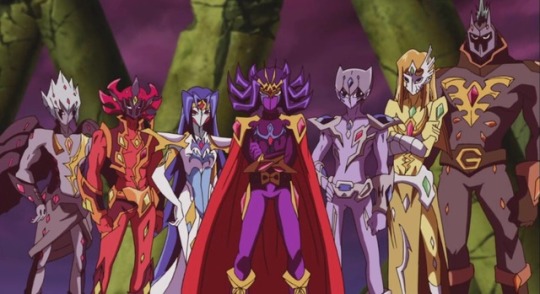
This is Don Thousand:
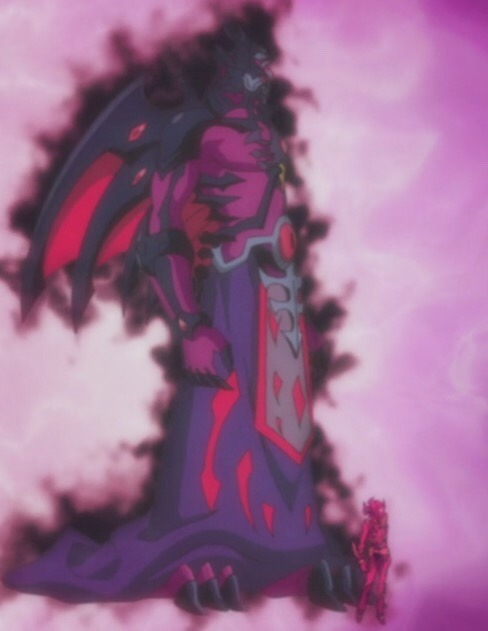
Ho-leey shit
So Don Thousand…
Don Thousand is one of the most mysterious Barians mostly attributed to his large size. Since sightings of Don Thousand are far and few between, there is actually an on-going debate in the Barianologist community centered around his true height. Here are some assumed height based on previous encounters:
Smol Don, approximately 10ft or 3m tall, larger than a standard Barian but not by much:
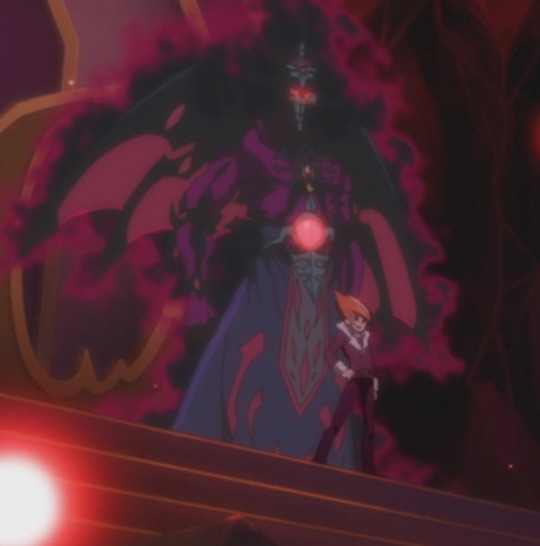
Tol Don, approximately 40ft or 12 m tall much larger than the standard Barian:
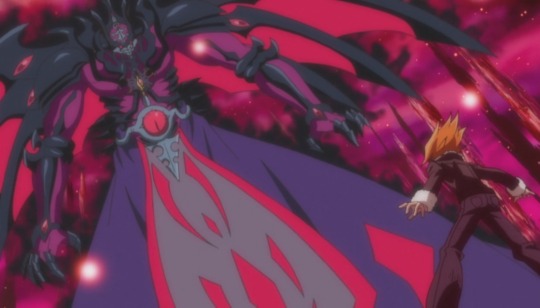
Big Boi Massive Don, approximately 150ft or 45m tall, outed as a hoax at the moment but possible if Don Thousand is given more time to grow:
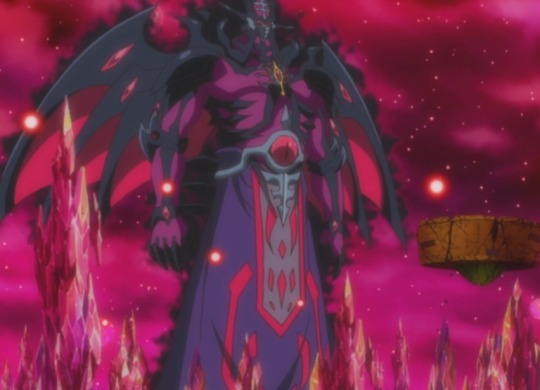
So far, the most agreed-upon and plausible size for Don is the “tol” variant for a number of reason. First off, the few people that encountered this Barian noted that he was much larger than the average Barian, but not towering by hundreds of feet tall. (plz for the love of god, imply square-cubed law doesnt apply for my sake im so tired) Secondly, despite not having consistent sightings of Don Thousand, there have been evidence of his carapaces, or the outer coverings:
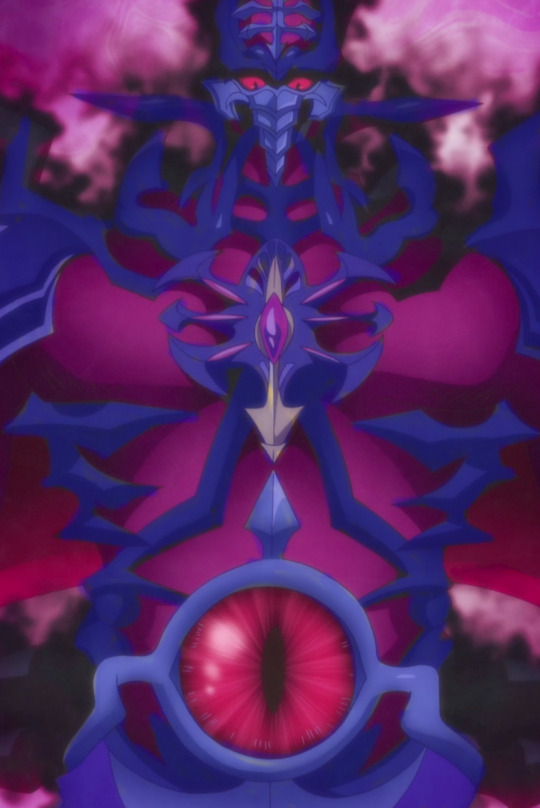
Depending on when and where the carapaces were discarded, along with the usage of other trace evidence, such as tracks on the sand or cleared pathways among the crystal forests, safe estimates could be made about his size.
Okay, but why is there even a debate on the size of a Barian? Especially if he is so large, shouldn’t it be a lot easier to spot him than the other, much smaller Barians?
Yes, Don Thousand is huge, but it is incredibly important to consider the type of environment he lives in. Earth is covered in cities and civilization, as well as satellites that keeps in eye on Earth’s surface. There are eyes everywhere, human or otherwise. If you plop a creature as large as Don Thousand onto Earth, he will be detected in a matter of minutes. On the other hand, Barian World is barren. The only thing on it is the vast acid sea, large crystalline structures, deserts, caves, and clumps of the dwindling Barian population. Not a lot of equipment is readily available to find Don Thousand either. He could be hidden within the acid sea or burrowed deep underground in molt. He could also be hidden in the fields of crystal trees, which are still large enough to hide a Barian his size, or buried under a layer on sand in the desert. Not to mention that Barians could grow, although rare, Don Thousand’s actual size could be changing as we speak. He may as well be a big boi massive since the last sighting. Unless we constantly send expeditions onto the hostile environment, Don Thousand will remain forever elusive and cryptic.
There is also a plethora of other factors that make this more complicated. His size, again, contributes to this. Going back to my previous analysis where I mentioned that Barians grow or repair using molts (in this case, the rock cycle), molting is a process where its usage and speed depend on the size of the molting creature. Look back to the hermit crab, who I relate the Barians to often, for the size disparities.
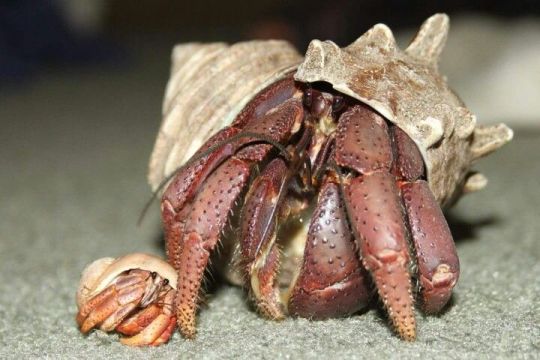
Like Barians, hermit crabs have large and small sizes as well, which isn’t strange for most arthropods. A mature hermit crab could be much smaller than another mature but older hermit crab. In the case of the Barians, a Barian like Nasch is mature but he isn’t large like Don Thousand. This isn’t to say that Nasch can’t grow large like Don Thousand, and he might as well in the future, but Don Thousand went through hundreds of molt cycles before he reached that size. He may continue to grow until his size becomes a major deterrent to his survival.
What makes this hard for us is that molting tends to be a process that gets longer the larger the creature is. For example, hermit crabs (Coenobita clypeatus) average molting times relative to their size in inches:
Micro/Teeny: Less than 1.0″ - 1 week
Small: 1.5″ - 3 weeks
Medium: 2.5″ - 6 weeks
Large: 3.0″ - 8 weeks
Jumbo: Greater than 3.0″ - 16 weeks
As you can see, the larger the crab gets, the more time it takes to complete a molt. Now if we consider that a Barian undergoes a similar process, ie the larger Barians take much longer to complete the rock cycle, it isn’t hard to believe that Don Thousand could take decades, perhaps centuries to molt. Which, may I remind you, is a very long time in the eyes of a dragon. It is easy to understand why Don Thousand is seldom seen or studied. But assuming that he stays above ground between molts (which means he stays above the crust for three times as long as he stays under), there should be a long period of time where he can be easily found, right?
This is where things get a little muddied. Due to his massive girth and thick, rocky shell, Don Thousand can stay submerged in the Sea of Ill Intent for a much longer period than a regular Barian (their shell could still be dissolved, yet the thickness relates to how long they can stay). This means that even if he finishes molting, he can remain hidden within the acid for an indisputable amount of time.
So all of this discussion about his size… What does this have to do with his ability to vore?…
Why plenty, in fact.
In nature there are certain animals that have natural predators when they are small/young (sally lightfoot crabs, elephants, rhinoceros, alligators, ect.) but as they grow larger and larger, they slowly lose that disadvantage. And guess which Barian is the biggest one around — yup, Donny K
By nature, Don Thousand is just an absurdly large prey creature.
His size alone is a deterrent against predators that want to challenge such a massive beast (except astrol). Even if an Astral Being, or many Astral Beings, attempt to harm him, he can easily swat them off since he is so big. And as previously mentioned, he can stay within the Sea of Ill Intent to avoid the deadly predators if he really don’t want to be bothered. To summarize, Don Thousand is highly undesirable prey who is much more trouble than he’s worth.
Understanding this, the other Barians do not follow in Don Thousand’s footstep for a couple of reason:
1) Consistent shape and size means they don’t need to constantly get new carapaces. Every time a Barian makes a drastic change to their body, they must find or create new carapaces that will fit their new form, either by carving a completely new piece or altering their old one. Unless they prepared it before going underground to molt, the Barian will be without carapaces (which protects them from predators) for an unreasonable amount of time, increasing their chances of being killed.
2) Cost of maintaining a body that large is very high. We do not know what fuels a Barian, but the cost of making/transporting energy through a lengthy body, moving high-density limbs, and molting is very high for such a large Barian. If they expend all the energy inside their core without replenishing it somehow (solar power?), they might die of exhaustion.
3) Molting is dangerous but necessary to an extent. It consumes a lot of energy to dig down, melt, reform, rack-build, harden, and dig up, and this process is only harder as the Barian grows bigger. They can also face other dangers in mid-molt, such as being uplifted or disturbed by another Barian, and as the longer they have to stay underground, the chances of being disturbed only increases. For arthropods, interruptions during molt could be fatal or leave them deformed until their next molt. For Barians, molting should only be deployed if they need to repair their shell or work on their rack to ascend in their pecking order. Larger size is not a necessity nor is it worth it most of the time.
The large size is useful as a defense mechanism and trait for the pecking order, yet overcoming the threshold to reach that size is difficult and more trouble than it’s worth, especially since most Barians already have an adequate defense mechanism. Don Thousand is one of the few, perhaps only, Barian that chose to go the “larger size” route. This is made possible for one very critical reason — where he chooses to molt. It is difficult to pinpoint this incredible fact, but Don Thousand molts under the Sea of Ill Intent.
The image below shows a crack on the seafloor, exposing a hotspot that Barians could use to burrow into and molt.
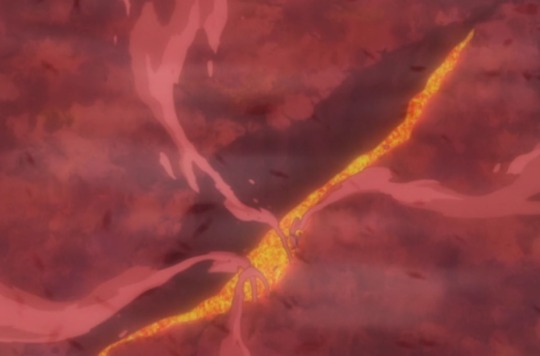
And the most conclusive evidence that Don Thousand specifically molts around here:

See that thing at the bottom of this hole? That is one of Don Thousand’s carapaces, located under the ocean, hidden in a whirlpool of acid and lava. Most Barians leave their carapaces close to them while they molt, usually several kilometers above the melting point to preserve it or prevent its destruction. The fact that a Don Thousand carapace can be found under the sea strongly suggests that Don Thousand is located very closely to this spot, several kilometers deep into the ground.
Doing this solves some of the issues stated above:
1) Consistent shape and size means they don’t need to constantly get new carapaces. With Don Thousand’s size, he is able to stay in the acid for a long time without feeling substantial damage to his vital organs. Since the acid will protect him from being attacked while he is carapace-less (not that he has to worry about that), he is given plenty of time to make new ones before he needs/wants to emerge.
2) Cost of maintaining a body that large is very high. The cost of maintaining the body is still high. However, I believe that the effect is mitigated since Don Thousand may be a Barian with a lot of energy to begin with. His core energy (or rate of photosynthesis) may be unnaturally higher than the rest of the Barians, thus he is able to grow large to begin with. Furthermore, Don Thousand doesn’t need to worry about predators at that size. He wastes little energy dealing with them (fleeing, defending, fighting, ect.) and this is the trade-off he chooses.
3) Molting is dangerous but necessary to an extent. The acid sea deters offensive Barians and Astral Beings from harassing him while he is molting, unless they want to venture far and deep into the ocean, risking their life in the process. Uplifting will also only bring him in contact with the acid, where he can promptly dig back down. This is much safer in comparison to being exposed to predators on land.
^The above ends up creating a simple positive feedback loop where his large size prevents the acid from harming him, allowing him to molt into a larger size, which in turn protects him from the acid even more.
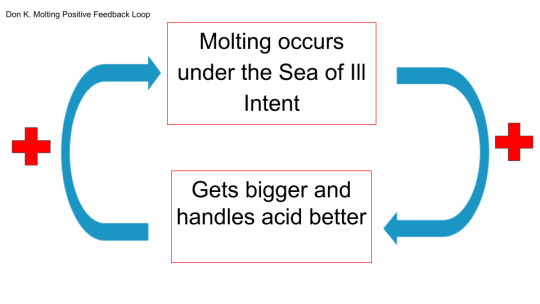
(Smaller Barians have a hard time breaking into this loop.)
Taking into account that his massive size will quite easily place him on top of any pecking order based on that alone, where exactly does Don Thousand fit? I’ll get into the idea of “Barian Colonies” in my discussion of the Fearsome Foursome later, but adding Don Thousand into a pecking order isn’t as simple as it seems. Actually, it is really simple, but there are some factors that complicate the issue.
Due to his large size and the circumstance of his molting, Don Thousand seldom spends any time with the other Barians. If he isn’t in molt, he most likely spends his time within the sea. It takes a lot of energy to move around and if there isn’t an urgent need to emerge from the acid, he will stay submerged until the next molt (the only reason I can think of as to why he would emerge would be to photosynthesize, if Barians do that, or maybe harass the local Barian population). This means that Don Thousand is severed from the Barian pecking orders for the most part, but I assure you that if he does show up, he could effortlessly establish himself into the society for more than just his ginormous girth.

So this brief overview covers a couple of things about Don Thousand that is, in my opinion, highly fascinating. Although it isn’t clear yet, Don Thousand’s rocky shell and carapace borrow certain unique elements from the other Barians. Examples of shared defense mechanisms include:
”SWISH” mechanism* —> Scritch, Erazor, Mr. Heartland (FF)
Talons capped with carapace —> Scritch, Mr. Heartland (FF)
Insignia* —> Unique to Seven Emperor Barians (SE)
Center eyeball —> Mr. Heartland (FF)
This tells us a couple of things. Either the smaller Barians adopt traits from Don Thousand and incorporate it into their own body plan… OR Don Thousand incorporated some of the best defense mechanism of the smaller Barians into his form, thus increasing his overall fitness by being the best of the best, drastically reducing any chance he has of being killed. The implications of this is that Don Thousand doesn’t belong to one Barian group but to many Barian groups, and he reigns over all of them whenever he emerges from the ocean. Think of Don Thousand as a ���God of the Barians” if you will. He will always be at the top of the pecking order (although the presence of an Insignia* suggests that he is closest to the Seven Emperor Barians).
*Further explanation in latter half
Final Consensus: Despite being as intimidating as a predator, Don Thousand is still a prey Barian who utilizes his large size and in-common traits to avoid predation. He’s just very large.
heyyo fearsome fucksome time mothertruckers
Moving on from the God that is Don Thousand, let’s examine the Fearsome Foursome.
I know what you want to hear. “Dyzarc! What the fuck are you doing. Where in the world does the Fearsome Foursome fit into the Barian pecking order?? Does Nasch get dethroned by these buggy barbarian bozos?”
To begin, upon looking at the two groups below:

I do not believe it is logical to integrate the Fearsome Foursome into the Seven Emperors pecking order.
Why?
Simply put, these Barians groups do not belong together. Barians are similar to orca pods on Earth.
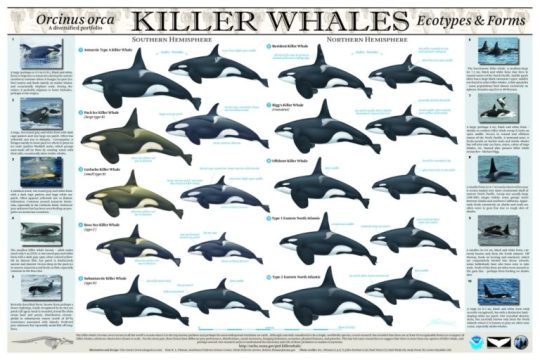
^^Example of different orca types due to regional differences. The same concept applies to Barians, but they show more severe variation due to the differences in their environments as well as natural variation as a direct result of unique rack-building and inconsistent molting environments. Different cultures also mean that the groups are not exactly equal to each other*
*This is not to say one group is inferior or superior to the other, but they are built for different purposes and thus are not comparable
To be frank, the Seven Emperor Barians are actually very easy to distinguish from other groups by examining their physical appearance alone. The most concrete evidence of a Seven Emperor Barian is to look on their chest for a distinctive carapace, an Insignia, seen here:
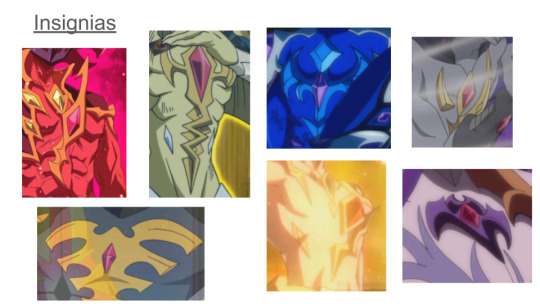
SIDE-NOTE: Another Barian with an Insignia is Don Thousand. This provides further evidence that he may be a part of the Seven Emperor colony or allude to the idea that Don Thousand is truly the “Barian God” that presides over every Barian colony, thus adopting the customs and traits of each group (Ex. Wings and Needle (swish) of the Fearsome Foursome) in order to better his survival rate.
Habitat and behavior also plays a major role in separating the groups, which applies more to the Fearsome Foursome due to their unique circumstance, but to simplify the topic, a general rule of thumb is:
Insignia = SE
No Insignia = Not SE
The Fearsome Foursome Barians all lack an Insignia and therefore should not be included within the Seven Emperor pecking order. Instead, they have their own pecking order established, which relies on different traits than the ones of the Seven Emperor Barians.
Of course, a difference in body structure doesn’t inherently discern a Fearsome Foursome Barian from a Seven Emperor Barian, but these physical characteristics (just look at them and you can see that something is amok) tells us that the Fearsome Foursome Barians are reacting to something that Seven Emperor Barians are not. However, since their body plans stem from the presence of Astral Beings, a rather uniform factor all things considered, this tells us that the Fearsome Foursome Barians are tailoring their form in response to the Astral Beings specifically.
But how could this happen? A Barian is a Barian is a Barian. Shouldn’t they all be a single entity/rely on the same mechanisms since they live on the same planet?
It isn’t completely clear what truly distinguishes a Fearsome Foursome Barian to a Seven Emperors Barian (and any other colonies) aside from the Insignia or why the Barians separate themselves into colonies — although it could be due to a high territorial drive, since Barians need a lot space to molt, and the more populated the group, the harder it is to find a good spot to repair and regrow their form; creating colonies is a good way to ensure good molting locations or a safer place to live — but the best place to look is:
A) Where they live and What is the end goal of their body plan. These two are not mutually exclusive to each other.
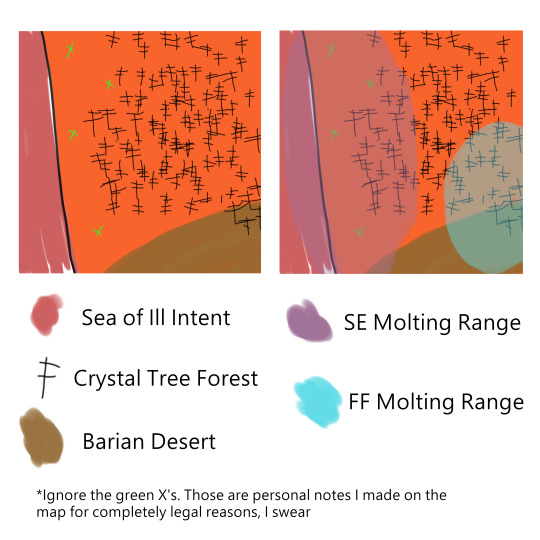
(Note: SE has more territory due to being a larger colony than the FF; larger colony = more space required for molting)
For the Seven Emperors, their habitat range is located here:
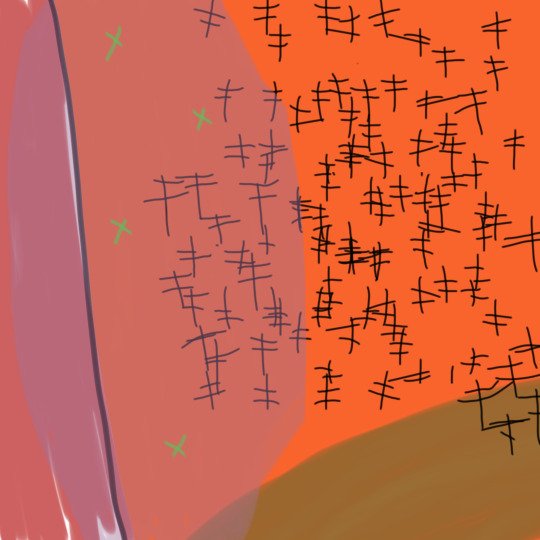
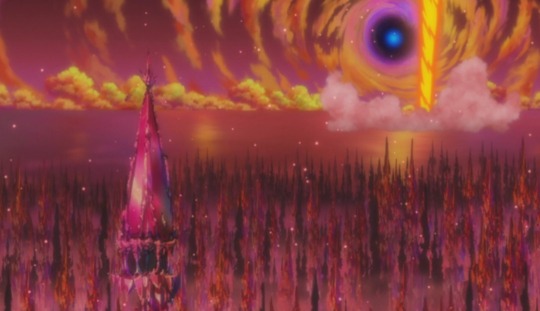
Along with residing in the enclosed forest, the biggest takeaway from this is that the Seven Emperor Barians live very close to the Sea of Ill Intent. As previously discussed, the acid sea allows for the Barians to effectively retreat into the acid from a pursuing predator. Once in the acid, they are generally safe from harm and it is highly unlikely that they will get killed. For the Seven Emperors, since they reside very close to the Sea of Ill Intent, when they are in danger, they can easily flee into the acid to protect themselves. As long as they do not wander too far from the sea, their primary defense mechanism is the Sea of Ill Intent.
This also supports how Don Thousand, a Barian who frequents the Sea of Ill Intent, has an Insignia that belongs to the Seven Emperors on his chest. Since Don Thousand and the Seven Emperors live in the same general area, by being in close proximity alone, Don Thousand is most integrated into the Seven Emperors colony and uses the Insignia (which does little for protection; used more for aesthetic/pecking order) for no other discernible reason than to just have it.
Now note where the Fearsome Foursome live:
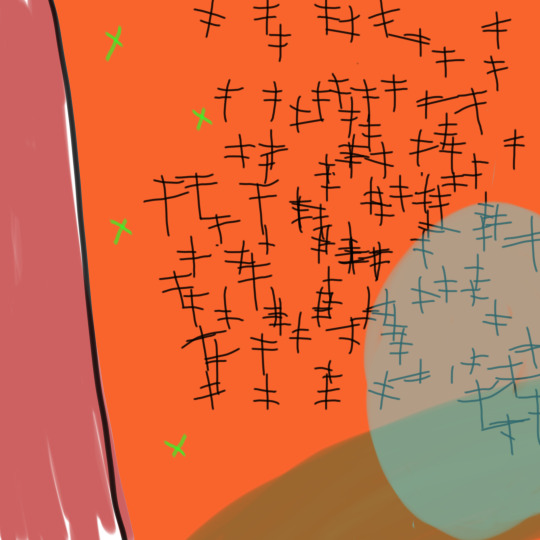

They are not near the sea. They live further inland within the crystal pillar forests or at the edge of the great Barian Desert, therefore they do not have a go-to “safe-zone” to retreat to if they are attacked. Their defense mechanism comes from whatever ingenious way they designed their bodies to protect themselves. I will cover these mechanisms later.
(Think of these as the differences between bonobos and chimpanzees. Different species, yet they are very closely related. The discussion of these two species is intriguing on its own, but what I want to get across is that bonobos are less aggressive than chimpanzees. This is mainly due to the environment they evolved in, where the bonobos’ ancestors came from a place of “paradise” or abundance in food while the chimpanzees’ ancestor came from a place of scarcity. To survive in the hostile and tough environment, the chimpanzees became more aggressive/ingenious, as in they have territorial fights, engage in hunting activities, and use tools to find food.)
The analogy above can be used to describe why the Fearsome Foursome are so different compared to Seven Emperors.
For the Seven Emperors, the end goal is to create a body for placement in the pecking order. They use a rack system to establish pecking order (which is more for aesthetic when compared to the utter shit the FF put onto their bodies). Although they can use the racks to protect themselves, the usage of a huge rack shows that they devote valuable resources (or have resources to spare) to make themselves more aesthetically pleasing. In a sense, the Seven Emperors are living in a more calm, less hostile environment.
For the Fearsome Foursome, the end goal of their body plan is to make anything worthwhile in terms of defense to make up for the lack of Sea of Ill Intent. Most of their molting energy is devoted into creating a body that will protect them from a gruesome death, which means they have less resources for rack-building. In a sense, the Fearsome Foursome are living in the more hostile environment.
Now that we covered why the groups are different, let’s examine what these differences are starting with a commonly shared trait among the Fearsome Foursome.
Aside from living in the same range, the clearest answer that links this diverse cast of Barians (Scritch, Chironex, Mr. Heartland, and Erazor) into the same category would be their usage of an elaborate Defense Mechanism. The Seven Emperors have a rocky shell and carapaces as their defenses against Astral Beings, and so do the Fearsome Foursome. Yet, the Fearsome Foursome Barian include those basic characteristics with the addition of something else. This could be seen in the carapaces alone.
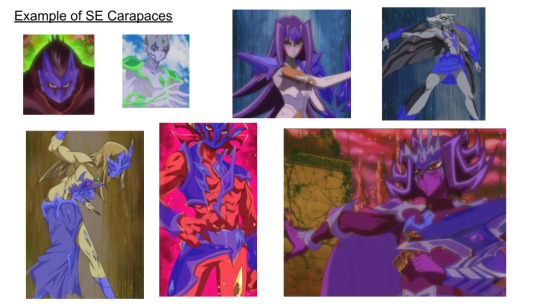

Even when excluding the Duel Disks, notice how heavily fortified the Fearsome Foursome Barians are compared to that of the Seven Emperors Barians. The Seven Emperors usually have smaller, one-sided pieces covering their shoulders or torso while the Fearsome Foursome’s carapaces tend to wrap around their entire body and more. This is one example to show the difference in defense mechanism between the two groups, but obviously the Fearsome Foursome goes further with this concept.
So back in the Don Thousand breakdown, I mentioned something called the SWISH. Swishing is a type of defense mechanism.
To “swish”, one will need a frontal protection and a dorsal protection. In the case of the Fearsome Foursome, they use a frontal needle and dorsal wings. Barians are extremely heavy and do not require food to survive, so it is very unlikely that the needle belongs to a mouth piece and the wing pieces aid with flight (so far, there has been no accounts of True Barians in flight). Therefore, the wings and needles serve another purpose.


Okay. So how does SWISH work?

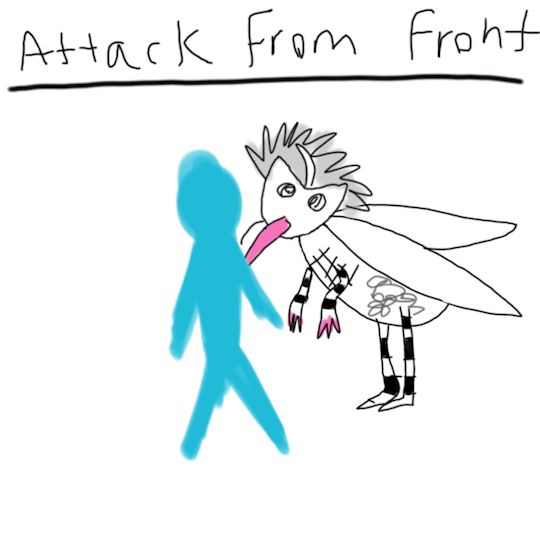
(Simulation; no Astral Beings were harmed in the video above)
Standing for SWord/needle and SHield/wings as well as the noises it makes when a Barian starts flapping or stabbing (use your imagination) and found in ¾ of the Fearsome Foursome Barians + Don Thousand, this is a basic but effective defense mechanism witnessed mainly in the vulnerable Fearsome Foursome Barians. The wings on the back provide backside protection. The Barian can also rapidly flap the wing pieces in order to shake off any Astral Being latching onto its backside. If the Astral Being tries to attack the Barian from the front, it must deal with a piercing needle constantly jabbing at it. This means that if an Astral Being wants to access the Barians’ core at all — which is located at the center of their chest — they must deal with the swish. Compared to the defense mechanism of the Seven Emperors, this is a very elaborate gimmick.
And speaking of elaborate gimmicks, I am going to focus heavily on Scritch and Chironex’s gimmicks for two reasons: they both have fascinating defenses, and Erazor and Mr. Heartland main defense strategy is “cover in spikes and carapaces” along with the swish mechanism. Overall, they are far less complex than Scritch and Chironex.
(Also I am a duper lazy dragon and feel like this torture is long enough and I really dont want to stare at barian heartland and erazor for another 2 hours.)
Let’s first look at Scritch, who is my new adopted son btw. Scritch is one of the most intriguing Barians out of this group, and this isn’t my personal preference towards him playing a role into this. Despite not being the most complex Barian, he certainly employs an interesting tactic (if my theories are correct).
Taking a glance at his coloration reveals a couple things about his mechanism, especially if we compare him to some similar species found on Earth.

This banded coloration is a product of a variety of things, such as the Barian utilizing disruptive coloration or warning colors. In this case, the Barian environment consist mainly of shades of reds, thus the disruptive coloration may not be very useful to this Barian. But what is useful? Warning colors. This is a commonly-used tactic in animals with brightly colored or flashy skin, such as poison dart frogs. The bright and striking bands on Scritch will make this Barian an easy target to spot and kill in the reddish tint of the planet, yet it could also be a signal to the predators that he is “not a good meal to eat”.
On one hand, the colors could be nothing more than a bluff, and it wouldn’t be too surprising if Scritch used the colors as a facade to scare off predators. But I think otherwise. If it was a bluff, Scritch wouldn’t have survive this long against bold or unaware Astral Beings, nor will his facade last if enough predators keep pestering him. My theory, and it is only a theory with no other evidence to back it up other than logic maybe, is that Scritch has pockets of some Alkali metals (pure sodium, for example) located in parts of his body like behind the mask carapace or within the bright red claws. For those unaware, Alkali metals are highly reactive to water, which is what the Astral Beings are made of, and can explode if they make contact with it. If an Astral Being attacks him, he can deploy the metals, harm the Astral Being, then skedaddle away while the predator is disorganized.
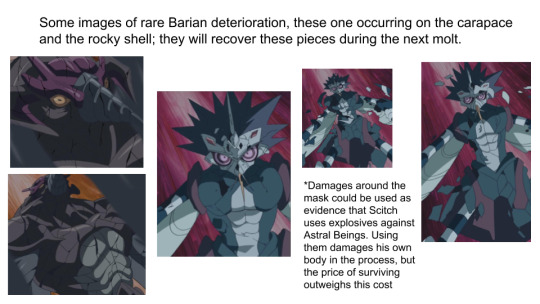
This could heavily damage the Barian in the process, but since they could always molt: temporary losing a limb > death. The banded coloration on his body signals to the Astral Beings to back off or else they’ll eat a face-full of sodium. This is only a theory however, and I cannot prove it unless we throw water at Scritch to see if he can explode. Which I absolutely cannot legally do because the Fearsome Foursome Barians are critically endangered (some problem with an invasive species, but the less we talk bout those three hooligans, the better) and I should not make Scritch explode.
Lastly, let us discuss a Barian who most likely won’t explode if water touches him.
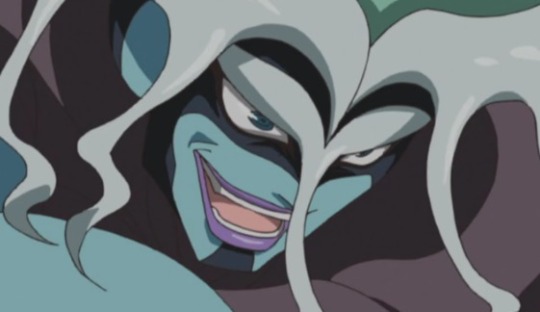
Chironex is another Barian with the presence of a fully-mechanical mouth. As with the other Fearsome Foursome Barians, Chironex doesn’t follow the body plan of a Seven Emperor. His body is covered mostly in thick carapaces, which is similar to the other Fearsome Foursome members. However, his physical appearance is drastically different than the other Fearsome Foursome Barians as well, such as the lack of protective wing pieces and needle-nose for effective swishing. At first glance, it’s difficult to tell where this one belongs. Based on his physiology, he doesn’t look anything like Fearsome Foursome or a Seven Emperor. He could’ve belonged to his own colony altogether.
This is a case where the similarities goes beyond their physical appearance. Take Canis lupus familiaris, for example, where the physical differences among each breed can look drastically different from one another yet they still fall under the same species (for dogs, they are considered the same species since most breeds can produce viable offspring if mated and they still have an exceedingly similar genome).

Like a breed of dog, Chironex is a Fearsome Foursome. Chironex lives within the boundary of the Fearsome Foursome range, interacts with the other Fearsome Foursome Barians, and his behavioral patterns follows that of a Fearsome Foursome. He also has a valuable place in the Fearsome Foursome pecking order. Despite not looking like one, Chironex is most certainly a Fearsome Foursome.
So knowing that, about his gimmick…
Chironex has a gimmick alright. And boy is it a gimmick. I want you to look at this image.
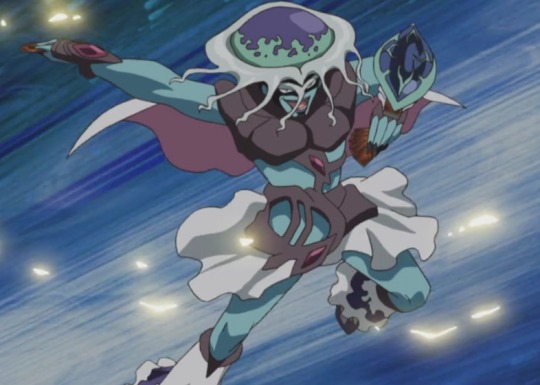
Note what the carapaces cover and what lies underneath the carapaces.
Now here’s our high-quality artist rendition of Chironex without his thick carapaces:

And here he is standing next to an Astral Being for comparison:

Notice something peculiar about this situation?
As you can see, the base form of Chironex (aka a Chironex without the layers of carapa—naked, i mean hes utterly nude) looks strikingly similar to the form of an Astral Being. Very smooth with a bluish tint, and a mouth, which is an extremely important body part on an Astral Being. And it is absolutely no coincident that Chironex looks like an Astral Being.
It is completely deliberate because Chironex uses a very advance form camouflage — mimicry. Not only does his defense mechanism involve mimicking another species but he is mimicking his predator species. This means his facade has to be very convincing if he wants to survive. Impressively enough, the behavior of this Barian also changes in order to aid his survival, such as his fascination with water and so-forth. Furthermore, Chironex’s base form has a very “jellyfish” feel to it. This is noteworthy because jellyfishes are comprised of 95% water, give or take, and basing himself around jellyfishes add more layers onto his mimicry.
The change in behavior coupled with well-done mimicry is one of the most elaborate defense mechanism in the natural world, so Chironex obviously has a good place in the Fearsome Foursome pecking order.
*In my opinion, I find the idea of exploding Scritches to be a lot more interesting than mimicry but y’kno how it is.
Here is the pecking order of the Fearsome Foursome:


And here is the pecking order of the Fearsome Foursome + Seven Emperors + Don K. for those curious on how the Barians compare to each other (if they had to beat each other up or sumthin idk)

And here’s the pecking order based on what I think the pecking order should be. No bias or anything, just based on logical progression

OKAY. If you’re still reading this, congrats! I love you.
We are on the final topic of this discussion. The VOREeee. Or are all Barians innocent or are only the Seven Emperors innocent?
Let’s look at the candidates for this:
Seven Emperors - Previously discussed
Scritch and Erazor - SAFE*
Don Thousand - SAFEish**
Chironex and Mr. Heartland - UNSAFE feel free to vore with em you sick fucks i know i will***
* Scritch and Erazor lack a visible mouth like the rest of the Seven Emperors, so they do fall under the “innocent” Barians.
**Don Thousand is a strange case due to one specific scene.
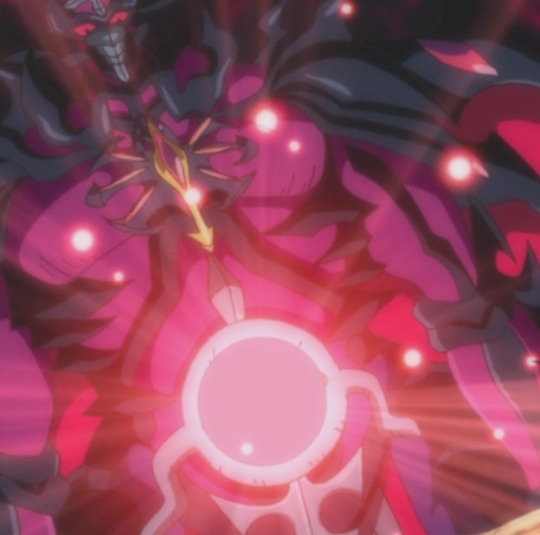
Right here, Don Thousand’s lowest eyeball turns into a gaping hole and proceeds to inhale Vector into it. This is clearly vore in some sense of the way, which I will not deny. HOWEVER, this opens the door to the concept of eye vore (not strange considering that anal vore, navel vore, cock vore, you-name-it exists) and since all the Barians have eyeballs, or what appears like functioning eyeballs, they are all capable of performing eye vore. wtf i didnt think of that and I do not know what to do with that information except say go nuts.
***With Chironex, I am willing to let him off the hook since he is involved in the act of mimicry, so the mouth could be false. This doesn’t let him off the hook for vore, of course, but my explanation is that the mouth is non-functional because it is the sole result of a mimicking disguise.
With Mr. Heartland…
uh his mouth is a…
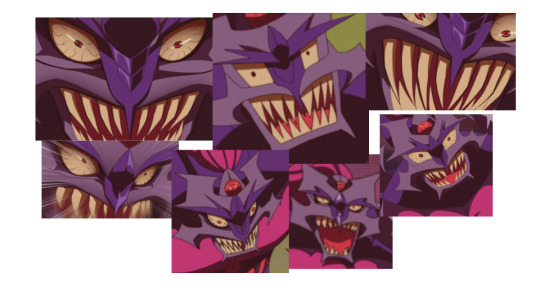
oh god jesus chrisus hold up,, let me check my notes
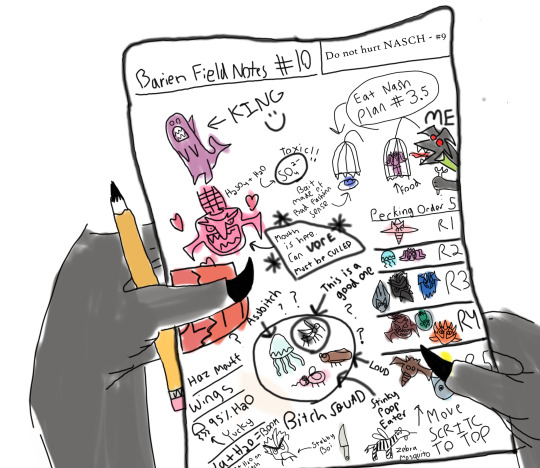


#ask#*miyamoto voice* never ask me for anything ever again#this is my worst idea yet#i never want to look at another stupid barian for as long as i live#yo anon thanks for making me realize how beast scritch is#if you pester me enough maybe ill dig into heartland and erazor#but im gonna be busy again and prob wont get it done till after june#long post#dyzarc draws#dyzarc ramblings#barian biology#scritch#kaninja#mr heartland#erazor#semimaru#kurage#chironex#don thousand#barian tag
46 notes
·
View notes
Text


Mission Impossible (crab version)
Caught him in the act. Maybe I should change Nofoa’s name to Houdini, eh? I picked him up and moved the thermometer (hopefully) out of his reach.
#bugs#the crabitat#hermit crabs#Nofoa#Crustacea#Malacostraca#Decapoda#Coenobitidae#Coenobita#Coenobita clypeatus#original content
4 notes
·
View notes
Text
Hello there!

#dottie#hermit crab#hermit crabs#hermies#pet#pets#shell#shells#purple pincher#coenobita#coenobita clypeatus#cute#adorable
31 notes
·
View notes
Video
youtube
Soldier Crab - Caribbean Hermit Crab (Coenobita Clypeatus)
0 notes